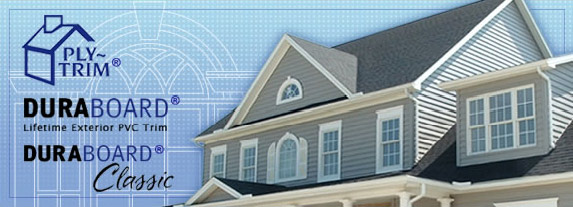EXTERIOR
PAINT SCHEDULE
DuraBoard® (Field Applied Primer and Finish) Trim Soffit
Latex Finish
a. Gloss Finish
1st Coat: S-W A-100® Exterior Latex Wood Primer, B42W41
(4 mils
wet, 1.4 mils dry)
2nd Coat: S-W SuperPaint® VinylSafe™ Exterior Acrylic
Gloss, A84 Series
3rd Coat: S-W SuperPaint® VinylSafe™ Exterior Acrylic
Gloss, A84 Series
(4 mils
wet, 1.4 mils dry per coat)
b. Satin Finish
1st Coat: S-W A-100® Exterior Latex Wood Primer, B42W41
(4 mils
wet, 1.4 mils dry)
2nd Coat: S-W SuperPaint® VinylSafe™ Exterior Acrylic
Satin, A89 Series
3rd Coat: S-W SuperPaint® VinylSafe™ Exterior Acrylic
Satin, A89 Series
(4 mils
wet, 1.44 mils dry per coat)
c. Flat Finish
1st Coat: S-W A-100® Exterior Latex Wood Primer, B42W41
(4 mils
wet, 1.4 mils dry)
2nd Coat: S-W SuperPaint® VinylSafe™ Exterior Acrylic
Flat, A80 Series
3rd Coat: S-W SuperPaint® VinylSafe™ Exterior Acrylic
Flat, A80 Series
(4 mils
wet, 1.4 mils dry per coat)
SURFACE PREPARATION:
a. Proper product selection, surface preparation, and application affect
coating performance.
Coating integrity and service life will be reduced because
of improperly prepared surfaces.
Selection and implementation of proper surface preparation
ensures coating adhesion to the
substrate and prolongs the service life of the coating
system.
b. Selection of the proper method of surface preparation depends on
the substrate, the environment,
and the expected service life of the coating system.
Economics, surface contamination, and the
effect on the substrate will also influence the selection
of surface preparation methods.
c. New cellular vinyl composite board: The surface must be clean, dry,
scuff sanded and in sound
condition. Remove oil, dust, dirt, or other contamination
to ensure good - adhesion. Clean
thoroughly by scrubbing with a warm, soapy water solution.
Rinse thoroughly. Painting with
darker colors may cause siding to warp, unless SuperPaint®
VinylSafe™ is used.
d. Previously Coated Surfaces: Maintenance painting will frequently
not permit or require complete
removal of all old coatings. However, all surface contamination
such as oil, grease, loose paint,
mill scale, dirt, foreign matter, rust, mold, mildew,
loose mortar, efflorescence, and sealers must
be removed to assure sound bonding to the tightly adhering
old paint.
Glossy paint surfaces must be clean and dull before
repainting. Thorough washing with an
abrasive cleanser may clean and dull in one operation,
or, wash thoroughly and dull by sanding.
Spot prime any bare areas with an appropriate primer.
Note that any surface preparation short of total removal
of the old coating may compromise the
service length of the system. Check for compatibility
of the recommended coating system by
applying a test patch, covering at least 2 to 3 square
feet. Allow surface to dry one week before
testing adhesion per ASTM D3359. If the coating system
is incompatible, complete removal is
required.
WARNING! Removal of old paint by sanding, scraping or
other means may generate dust or
fumes that contain lead. Exposure to lead dust or fumes
may cause brain damage or other
adverse health effects, especially in children or pregnant
women. Controlling exposure to lead or
other hazardous substances requires the use of proper
protective equipment, such as a properly
fitted respirator (NIOSH approved) and proper containment
and cleanup. For more information,
call the National Lead Information Center at 1-800-424-LEAD
(in US) or contact your local health
authority.
Remove mildew before painting by washing with a solution
of 1 part liquid Household bleach and
3 parts of warm water. Apply the solution and scrub
the mildewed area. Allow the solution to
remain on the surface for 10 minutes; however, do not allow the solution to dry on the surface.
Rinse thoroughly with clean water and allow the surface
to dry 48 hours before painting. Wear
protective glasses or goggles, waterproof gloves, and
protective clothing. Quickly wash off any of
the solution that comes in contact with your skin. Do
not add detergents or ammonia to the
bleach/water solution.
e. No exterior painting should take place immediately after a rain,
during foggy weather, when rain
is predicted, or when the temperature is below 50°F
unless the specified product is designed for
the marginal conditions.
INSTALLATION
a. Apply all coatings and materials with manufacturer’s specifications
in mind. Mix and thin
coatings according to manufacturer’s recommendation.
It is recommended that the door shall be
primed and finished on all sides. It is also required
that all door sections be finished prior to
installation.
b. Do not apply to wet or damp surfaces.
1. Test new substrate for moisture content.
2. Do not leave or store unfinished doors outside.
3. Cellular vinyl composite board should not be finished
under very humid conditions.
c. Apply coatings using methods recommended by the manufacturer.
d. Uniformly apply coatings without runs, drips, or sags, without brush
marks, and with consistent
sheen. Use non-plasticizing flexible PVC weather stripping.
e. Apply coatings at spread rates required to achieve the manufacturer’s
recommended dry film
thickness.
f. Regardless of number of coats specified, apply as many coats as
necessary for complete hide,
and uniform appearance.
PROTECTION
a. Protect finished coatings from damage until completion of project.
b. Touch-up damaged coatings after substantial completion, following
manufacturer's
recommendation for touch up or repair of damaged coatings.
Repair any defects that will hinder
the performance of the coatings.



